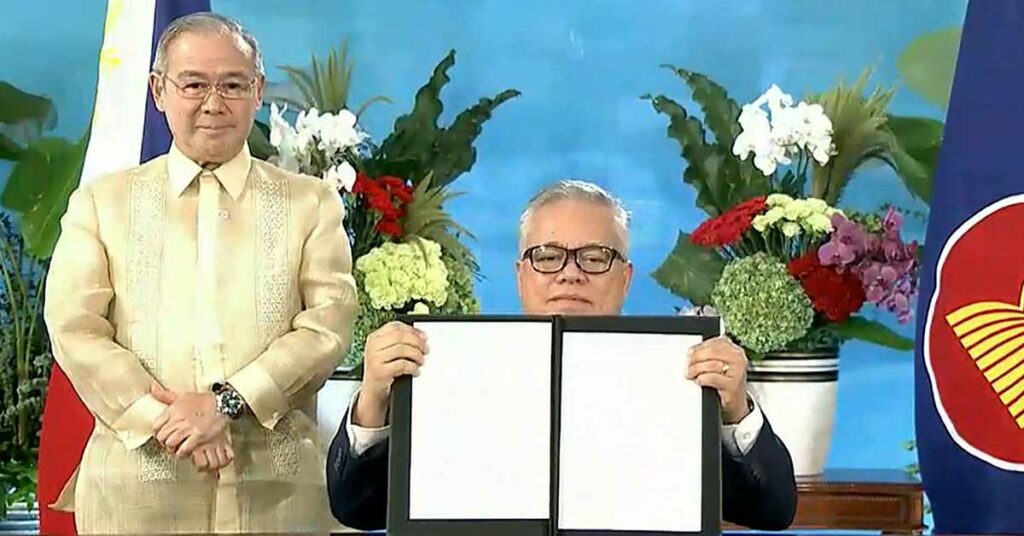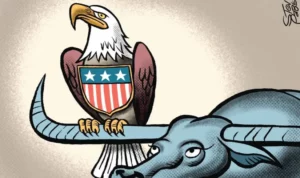
The Senate’s last session under the 18th Congress came to a close on 1 June, 2022 with no mention, deliberation, and ratification of the Regional Comprehensive Economic Partnership (RCEP). This means that the Philippines has once again missed the opportunity to be part of the largest trade deal the world has ever seen.
RCEP is larger than other regional trading blocs, even larger than the European Union (EU).
In September 2021, outgoing President Rodrigo Duterte signed the ratification of RCEP, but for RCEP to be fully effective, it needs the concurrence of the Senate, which it failed to do.
Why RCEP?
RCEP came into force on 1 January, 2022. RCEP is a trade agreement involving the 10- member states of the Association of Southeast Asian Nations (ASEAN) and their largest free trade agreement (FTA) partners, namely China, South Korea, Japan, Australia, and New Zealand. The trade pact covers trade in goods and services, intellectual property, etc.
From a global standpoint, based on 2020 data from the World Bank, ITC Trade Map, and UNCTAD World Investment Report, RCEP accounts for 29 percent of total gross domestic product (GDP) or US$25.8 trillion; 29 percent of total trade (US$10.1 trillion); 33 percent of global inward foreign direct investment (FDI), 47 percent of Global FDI and 29 percent of the total population of 2.3 billion people.
Furthermore, based on the November 2020 UNCTAD Investment Trade Monitor, the RCEP region speaks for 50 percent of global manufacturing output; 50 percent of global automotive output; 70 percent of electronic products; 26 percent of global value chain (GVC) trade volume; the main GVC hubs of Japan, China, and Korea; 60 percent for electrical/machinery/ petroleum/chemicals, textile/apparel, metal, and transport equipment; and 35 percent contribution to global exports of electronics and machineries.
RCEP provides a framework for regional economic and trade cooperation in the broader Asia Pacific region. It integrates and optimizes the region’s economic and trade rules in a wide range of fields, including goods, services, investment, intellectual property rights, e-commerce, and competition policy, which will further promote the integrated development of industrial chain, supply chain, and value chain in the region.
RCEP helps and encourages the inflow of foreign investments, facilitates an opportunity to partner and form joint ventures within the region, and allows greater participation of more service providers in vital sectors such as manufacturing, creative sectors, financial services, aerospace, and shipbuilding, research and development (R&D), IT-BPO, professional services, education services, and energy, among others.
RCEP is expected to bring tangible new opportunities to the business community in the Asia Pacific region, especially to create favourable conditions for those small and medium-sized enterprises (SMEs) so that they could better participate in regional economic and trade cooperation and tap into markets in various countries by enjoying policy dividends of this agreement.
Indeed, RCEP members will benefit much from the trade agreement, if not in the short-term, at least in the long run.
Reservations?
President-elect Ferdinand “Bongbong” Marcos Jr. has reservations about pushing for the ratification of RCEP. Marcos wants to assess the country’s competitiveness first before pursuing the ratification of RCEP. He wants another look at RCEP and to study about its possible impact on farmers. He expressed concerns about the country’s competitiveness, especially that of the agricultural sector and local farmers, and he wants the country to be competitively ready first before ratifying RCEP.
However, entering a trade pact like RCEP and opening the economy to the world is not necessarily a new thing for the Philippines. The Philippines is a member of the World Trade Organization (WTO), through which a significant increase in tariff bindings, extensive tariff reductions, elimination of quantitative and other non-tariff measures, and commitments in many services sectors have been introduced.
At the very onset, the country’s participation in the WTO has liberalized trade on a multilateral basis, reduced trade barriers, and lowered tariffs. Also, trade is already liberalized in ASEAN Plus One FTAs such as the ASEAN Australia New Zealand FTA, ASEAN China FTA, and ASEAN Korea FTA.
Concerning the ambivalence of the President-elect on RCEP vis-à-vis the agricultural sector, it has been pointed out by the Department of Trade and Industry (DTI), no less than the outgoing Trade Secretary Ramon Lopez that the agricultural sector is safe with RCEP precisely because no new highly sensitive agricultural products were included from the country’s Schedule of Commitments.
These highly sensitive agricultural products include swine meat, poultry meat, potatoes, onions, garlic, cabbages, sugar, carrots, and rice. This means that tariffs still protect these products. A tariff is a tax imposed by the government of a country on imports or exports of particular goods.
DTI Assistant Secretary Atty. Allan B Gepty emphasized in a forum sponsored and organized by the Association of Philippines-China Understanding (APCU) that the RCEP agreement provides vast opportunities for the agricultural sector; ranging from enhanced market access, trade facilitation measures, time-bound consultation in addressing trade issues to more investments in research and development in agricultural sciences and even manufacturing.
Gepty said, “Our farmers and producers should view RCEP as an opportunity for them to have stable access to cheaper farm inputs and implements such as fertilizers, pesticides, and farm machineries. They can also export their products to the RCEP region at a preferential and more trade facilitative arrangement. In the process, RCEP will encourage investments in food processing and even Research & Development (R&D) in agricultural sciences and technology. In sum, our agricultural sector will reap these benefits while at the same time enjoying tariff protection on certain agricultural products.”
Data dictates that around 74 percent of the country’s importation of fertilizers is from RCEP member states like China, Indonesia, Malaysia, Korea, Viet Nam, and Japan, in the same manner, that around 70 percent of the importation of insecticides is also from RCEP countries like China, Malaysia, Indonesia, Japan, and Korea. Also, when importing agricultural machineries, around 78 percent of them are from RCEP countries like Thailand, China, and Japan.
Likewise, there are safety nets in place to counter any risks and protect the Philippines economy and the public from any unforeseen circumstances, and these include (a) grace period /flexibility to implement new commitments; (b) trade remedies; (c) modifications of commitments in exceptional circumstance; (d) investment reservations; and (e) exceptions.
On this note, perhaps, concerning agriculture, what the Philippines should do is probably not shy away from RCEP because it is akin to protectionism or a protectionist policy. Instead, the incoming administration should focus more on modernizing the agricultural sector.
A September 2020 report by the World Bank titled, “Transforming Philippines Agriculture During COVID-19 and Beyond” states the need for Philippines agriculture to be transformed into a dynamic, high-growth sector essential for the country to speed up recovery, poverty reduction, and inclusive growth.
This would mean that the incoming administration should further diversify and use modern agricultural technologies, spending more on R&D, infrastructure, innovation systems, market information systems, and biosecurity systems, which would result in faster poverty reduction and greater productivity gains through an overall modernization of the agricultural sector.
The report also states that interventions like farm consolidation (including cooperative farming schemes, for instance), better extension services, e-commerce, and investments in agribusiness start-ups can further advance the modernization of Philippine agriculture.
“These paradigm shifts will be crucial to meet the emerging domestic and global market opportunities while creating jobs, raising farmer incomes and ensuring the food security needs of the country, and meeting the new challenges of climate change,” said Dina Umali-Deininger, World Bank Practice Manager for Agriculture and Food for East Asia and the Pacific.
Thus, this would mean the next administration probably has to look and revisit the gains and impact of the agrarian reform program of the country to the overall health of the country’s agricultural sector and probably try to recalibrate and introduce some policy measures that are more relevant to the sense of time.
Furthermore, the country also has to study, learn, and note the best practices of countries whose agricultural sector is robust, strong, modernized, and widely integrated into the global market using information communication technology (ICT).
Advantages And Benefits
Aside from the abovementioned safety nets in place, the DTI highlighted the critical role of RCEP in boosting equitable economic growth, especially for MSMEs, through the expansion of regional trade, services, and investment linkages. It also emphasized the 4Cs through which the Philippines benefits from RCEP and which include, (a) cheaper costs for sourcing key inputs of the manufacturing sector; (b) convenience for businesses in trading with key FTA partners; (c) competitiveness for Philippine industries; and (d) complementation of existing government support programs.
The DTI further asserts that RCEP provides a wider cumulation area that allows Philippine exporters to source from 14 countries, including the country’s top import sources of raw materials (ASEAN and China). Moreover, based on some studies, other than its size, RCEP will reinforce regional supply chain integration by liberalizing rules of origin. It will allow traders to source intermediate goods from any of the 15 members with only one certification of origin and further enhance East Asia’s regional economic integration and significantly improve the overall business environment in the region. To note, an integrated hyper-sized market has been born out of RCEP, injecting strong impetus into regional and global economic growth.
Other equally noteworthy advantageous features of being part of RCEP include (1) simplified and unified rules; (2) less barriers; (3) advanced custom procedures; (4) less administrative cost and trade facilitative; (5) enhanced market access; (6) adopt rules and disciplines on e-commerce; (7) stronger Intellectual Property Rights (IPR) protection; and (8) implementation of competition policies.
Geopolitically speaking, RCEP is a win-through of ASEAN centrality because ASEAN was in the midst of the RCEP’s negotiation process. Thus, RCEP is a showcase of the middle-power diplomacy of ASEAN, which also means that ASEAN member states will be more or less key players setting the terms of engagements and rules played by RCEP.
Conclusion
In retrospect, joining RCEP at the soonest possible time would be to the advantage of the Philippines, while delaying will most likely results in lost opportunities for the country. Outgoing Trade Secretary Ramon Lopez stated that there would be consequences if the ratification of the trade deal was delayed.
He said, “as mentioned before if we don’t ratify, some investments will also shift towards RCEP-participating countries because those countries will enjoy market concessions in other RCEP countries. After the pandemic, this will affect our very good FDI (foreign direct investment) growth momentum and job generation goals. Each day we delay, there is a threat to missing trade and investment opportunities.”
As the DTI pointed out; by its sheer size alone and the extent of economic activities in the region, the Philippines needs to be part of RCEP. Hence, the Philippines must ratify RCEP and be a full pledge member of this trade agreement. Doing otherwise will be a disadvantage to the Philippines vis-à-vis other ASEAN member states.
Undoubtedly, RCEP is an essential agreement for the Philippines and the Asia Pacific region. It brought all 15 countries together in simplified trade processes and arrangements for the first time. Most importantly, RCEP is a genuine trade deal for Asia in Asia.
Source: The ASEAN Post
https://theaseanpost.com/opinion/2022/jun/05/why-rcep-important-philippines



